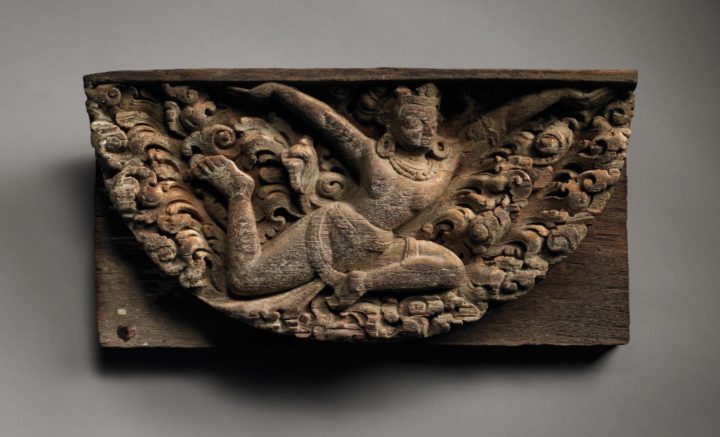
Two carved architectural elements in the collection of the Rubin Museum of Art in New York were identified as stolen by two groups dedicated to tracing looted Nepalese cultural heritage abroad. On September 17, Lost Arts of Nepal, which was founded in 2015 and primarily operates via a Facebook page, posted across its social media channels that a 17th-century wooden torana and a 14th-century flying wooden Gandharva in the museum’s collection were looted from Yampi Mahavihara, Lalitpur, and Itum Bahal, Kathmandu, respectively.
The Nepal Heritage Recovery Campaign (NHRC), an international effort by activists to document and secure the return of stolen sacred statuary (ideally to the temples and stupas from which they were seized), announced the same day at its official launch event at Nepal’s Patan Museum that the two artifacts were stolen. There is overlap between Lost Arts of Nepal and the newly inaugurated Campaign, as the anonymous administrator behind the Lost Arts of Nepal account, noted for their rigor, is on the Campaign’s advisory council.
The Campaign, which has alerted the Consulate General of Nepal in New York, publicly asked that the Rubin Museum repatriate the statues. The address given by Campaign vice chairman, journalist, and activist Kanak Mani Dixit revealed that the group had pinpointed the locations of more than 20 additional stolen items of Nepalese heritage internationally and reached out to 15 museums in the United States, United Kingdom, and France asking them to review their holdings of Nepalese objects.
The Rubin Museum acquired the intricately carved upper portion of a torana, or tympanum element of a temple gateway, in 2010, while the carving of a Gandharva, or divine musician, with arms outstretched mid-flight, entered the museum’s holdings in 2003. Both pieces of Newa devotional art were taken from Buddhist monasteries in Kathmandu Valley, as the in situ photographs from 1970 posted by Lost Arts of Nepal indicate (the exact date of the theft is currently unknown).
Though Nepal banned the export of ancient statues of deities through the Ancient Monuments Preservation Act in 1956, these and other objects of cultural heritage have been looted frequently since the 1980s — to the extent that one researcher, Jürgen Schick, estimated that over half of the region’s historical artworks have been stolen, from bronze idols to pieces of temple architecture. These sacred objects, part of a living culture in Nepal, are highly desirable on the art market and have scattered across museum and private collections in the United States and Europe.

In response to a 2018 Al Jazeera segment on sacred objects plundered from Nepal’s Mustang District, the Rubin Museum, which is dedicated to the culture and art of the Himalayan regions, released a statement asserting that it does not acquire material known or suspected to be stolen, adding that the institution has been working on an exhaustive cataloguing of its collection since 2016. “Should we — through our efforts in researching and documenting our collection or through inquiries by relevant authorities — learn that objects in our care have been documented as stolen or looted, the Museum will address all claims responsibly,” the statement read.
Of the most recent claims, the Rubin Museum told Hyperallergic:
We are aware of these claims and are addressing them carefully and seriously. The Rubin is committed to investigate thoroughly and in collaboration with the relevant authorities to determine the proper course of action. The museum has already engaged two scholars of Nepalese art and is in direct contact with the Consulate General of Nepal, New York, to further examine and research the known provenance of the pieces. Once we have more information on the assessment, we will determine appropriate steps, which could include restitution.
2021 has witnessed several high-profile returns of sacred statuary to Nepal, including a 10th-century stone statue of Uma Maheswar stolen from Gahiti that was repatriated by the Denver Art Museum, and a 12th-century stone statue of Lakshmi-Narayana looted from Patko Tol in 1984 that was returned by the Dallas Museum of Art.
0 Commentaires